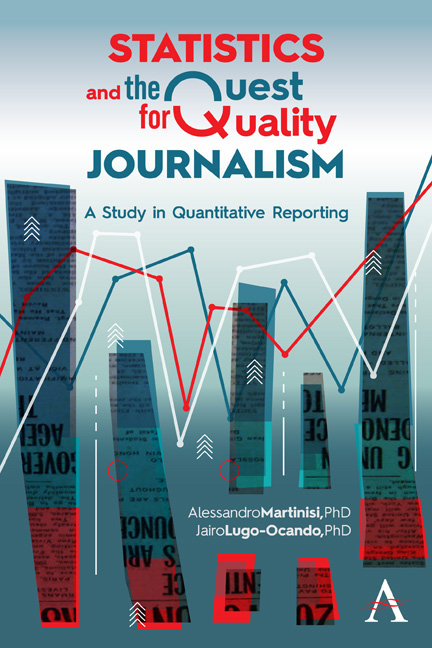Book contents
- Frontmatter
- Dedication
- Contents
- List of Illustrations
- 1 Introduction
- 2 Numbers as Information in the Information Society
- 3 The Never-Ending Debate on Quality in Journalism
- 4 Statistics in Journalism Practice and Principle
- 5 The Normative Importance of ‘Quality’ in Journalism
- 6 Journalism Meets Statistics in Real Life
- 7 The Ideology of Statistics in the News
- Epilogue
- References
- Index
6 - Journalism Meets Statistics in Real Life
Published online by Cambridge University Press: 07 November 2020
- Frontmatter
- Dedication
- Contents
- List of Illustrations
- 1 Introduction
- 2 Numbers as Information in the Information Society
- 3 The Never-Ending Debate on Quality in Journalism
- 4 Statistics in Journalism Practice and Principle
- 5 The Normative Importance of ‘Quality’ in Journalism
- 6 Journalism Meets Statistics in Real Life
- 7 The Ideology of Statistics in the News
- Epilogue
- References
- Index
Summary
Our central question, so far, has asked about the nature of the engagement between journalists and statistical data in the pursuit of quality. In so doing, we would want also to know if the quality statistics automatically lead to quality journalism. If so, we ought to know if the information quality then translates into quality journalism. Does the nature of a statistic's source affect the news reporting? What is the purpose of statistics in news reporting? Do journalists emphasize a certain type of statistics? What statistics sources do journalists use most often? And, how does the audience engage with statistically driven stories?
To answer these and other questions, we used a mixed-method approach, in which we have triangulated qualitative and quantitative methods as this ‘is major research approach’ (Johnson, Onwuegbuzie & Turner, 2007). The importance of such a triangulation is the validity of the results that can lead to a more balanced and detailed answer to the research questions by also comparing and contrasting different accounts of the same situation (Turner & Turner, 2009). The aim was to develop a ‘practical theory’ that would help to rationalize the issue under scrutiny (Altrichter, 2010; Altrichter, Posch & Somekh, 1993). We included content analysis, semi-structured interview, close reading and focus groups, which allowed us to carry out a multilevel assessment of the data. The overall mixed method used in this research should be understood in a broader ‘cross-sectional design’ (F. L. Cook et al., 1983; Johnston & Brady, 2002), which allows a combination of quantitative and qualitative research.
Therefore, this chapter presents the analysis of the data collected followed by a discussion of the research findings that resulted from each method. It provides a detailed account of the findings, in the hope that these results will elucidate the uses of statistics in articulating the five quality dimensions in news reporting.
Overall, our findings suggest that journalists tend to use statistical information as a tool to fulfil their deontological expectations of producing quality journalism. However, as it became clear from the interviews, one of the underlying motivations seems to also be the need to achieve credibility and authority, which entails a certain degree of building up the ability to persuade by means of trust.
- Type
- Chapter
- Information
- Statistics and the Quest for Quality JournalismA Study in Quantitative Reporting, pp. 93 - 152Publisher: Anthem PressPrint publication year: 2020



